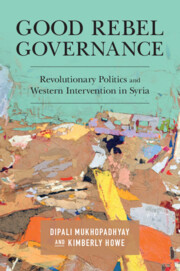36 results
Contents
-
- Book:
- Good Rebel Governance
- Published online:
- 01 June 2023
- Print publication:
- 15 June 2023, pp v-vi
-
- Chapter
- Export citation
2 - The “Good Governance Bazaar”
-
- Book:
- Good Rebel Governance
- Published online:
- 01 June 2023
- Print publication:
- 15 June 2023, pp 18-32
-
- Chapter
- Export citation
Index
-
- Book:
- Good Rebel Governance
- Published online:
- 01 June 2023
- Print publication:
- 15 June 2023, pp 225-228
-
- Chapter
- Export citation
10 - Revolutionary Possibilities and International Imaginings
-
- Book:
- Good Rebel Governance
- Published online:
- 01 June 2023
- Print publication:
- 15 June 2023, pp 157-176
-
- Chapter
- Export citation
4 - Studying Syria “from the Verandah”
-
- Book:
- Good Rebel Governance
- Published online:
- 01 June 2023
- Print publication:
- 15 June 2023, pp 53-67
-
- Chapter
- Export citation
Acknowledgments
-
- Book:
- Good Rebel Governance
- Published online:
- 01 June 2023
- Print publication:
- 15 June 2023, pp ix-x
-
- Chapter
- Export citation
6 - Saraqeb’s “Limited Access Order”
-
- Book:
- Good Rebel Governance
- Published online:
- 01 June 2023
- Print publication:
- 15 June 2023, pp 86-104
-
- Chapter
- Export citation
9 - The Syrian Interim Government as “Floating” Counter-State
-
- Book:
- Good Rebel Governance
- Published online:
- 01 June 2023
- Print publication:
- 15 June 2023, pp 140-156
-
- Chapter
- Export citation
1 - Introduction
-
- Book:
- Good Rebel Governance
- Published online:
- 01 June 2023
- Print publication:
- 15 June 2023, pp 1-17
-
- Chapter
- Export citation
Select Bibliography
-
- Book:
- Good Rebel Governance
- Published online:
- 01 June 2023
- Print publication:
- 15 June 2023, pp 211-224
-
- Chapter
- Export citation
7 - The Fervent Enclave of Darayya
-
- Book:
- Good Rebel Governance
- Published online:
- 01 June 2023
- Print publication:
- 15 June 2023, pp 105-120
-
- Chapter
- Export citation
8 - Aleppo’s Republican Guild
-
- Book:
- Good Rebel Governance
- Published online:
- 01 June 2023
- Print publication:
- 15 June 2023, pp 121-139
-
- Chapter
- Export citation
5 - Raqqa’s Caliphal Social Contract
-
- Book:
- Good Rebel Governance
- Published online:
- 01 June 2023
- Print publication:
- 15 June 2023, pp 68-85
-
- Chapter
- Export citation
3 - Reconceptualizing Rebel Governing Authority
-
- Book:
- Good Rebel Governance
- Published online:
- 01 June 2023
- Print publication:
- 15 June 2023, pp 33-52
-
- Chapter
- Export citation
Notes
-
- Book:
- Good Rebel Governance
- Published online:
- 01 June 2023
- Print publication:
- 15 June 2023, pp 177-210
-
- Chapter
- Export citation
Figures
-
- Book:
- Good Rebel Governance
- Published online:
- 01 June 2023
- Print publication:
- 15 June 2023, pp vii-viii
-
- Chapter
- Export citation
Copyright page
-
- Book:
- Good Rebel Governance
- Published online:
- 01 June 2023
- Print publication:
- 15 June 2023, pp iv-iv
-
- Chapter
- Export citation

Good Rebel Governance
- Revolutionary Politics and Western Intervention in Syria
-
- Published online:
- 01 June 2023
- Print publication:
- 15 June 2023
Winning Hearts and Minds for Rebel Rulers: Foreign Aid and Military Contestation in Syria
-
- Journal:
- British Journal of Political Science / Volume 52 / Issue 3 / July 2022
- Published online by Cambridge University Press:
- 18 June 2021, pp. 1333-1354
- Print publication:
- July 2022
-
- Article
- Export citation
Warlords and Coalition Politics in Post-Soviet States. By Jesse Driscoll. New York: Cambridge University Press, 2015. 264p. $103.00.
-
- Journal:
- Perspectives on Politics / Volume 15 / Issue 2 / June 2017
- Published online by Cambridge University Press:
- 08 June 2017, pp. 594-595
- Print publication:
- June 2017
-
- Article
- Export citation

